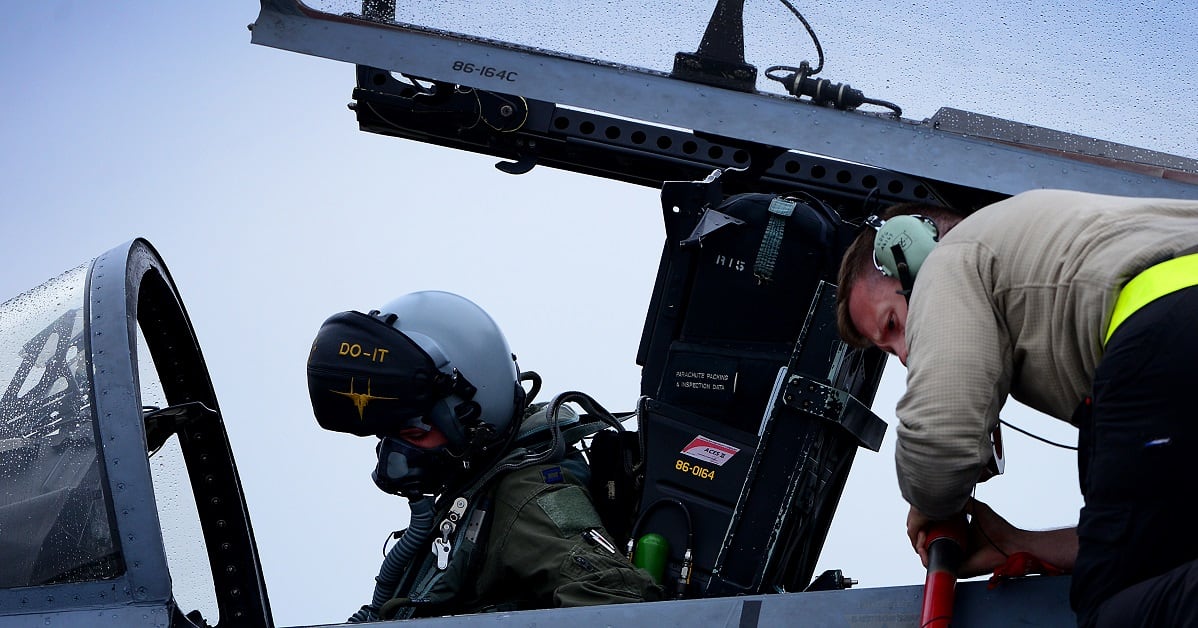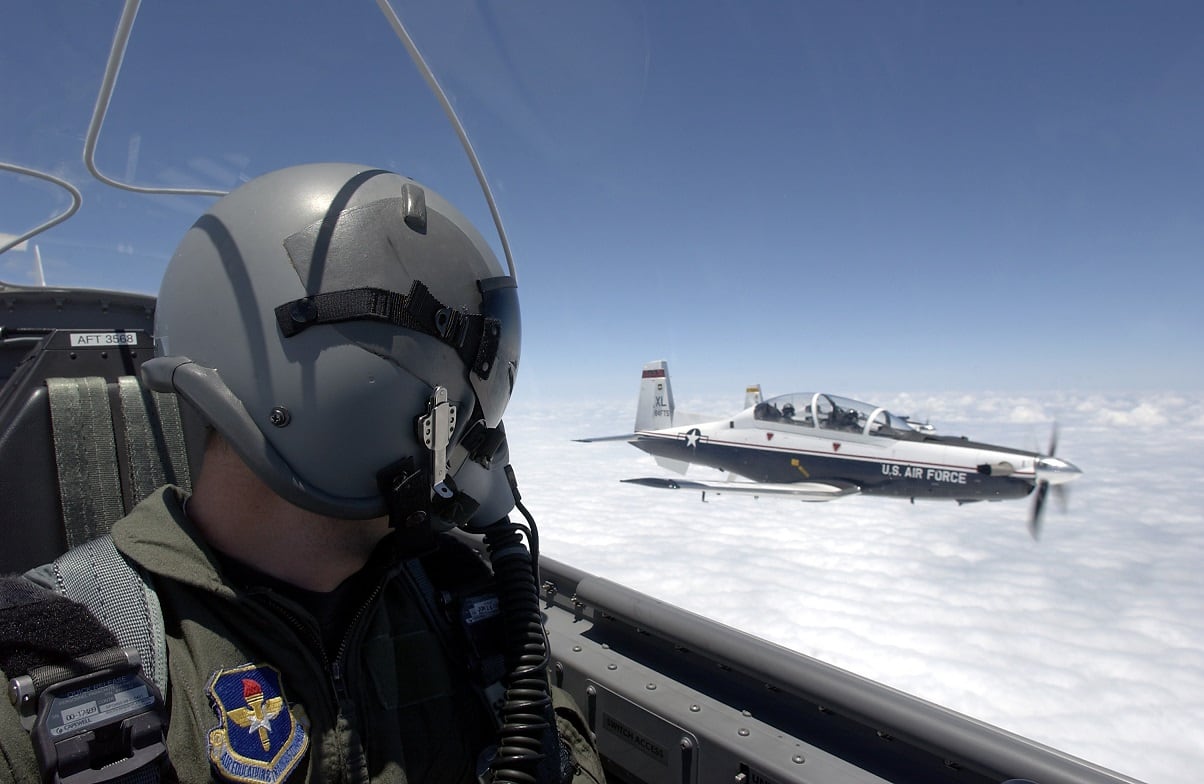WASHINGTON — The Air Force’s training command will now likely graduate 1,109 new pilots this year, a 10 percent drop from what it originally expected, due to a rash of physiological episodes in the service’s T-6 turboprop plane used for basic pilot training.
Earlier this year, the service grounded all T-6 Texan flights for almost a month after an increased number of unexplained physiological episodes, in which pilots exhibited symptoms of oxygen deprivation or other oxygen-related physical problems.
All of the Air Force’s T-6s should be back in the skies as early as this summer after the service makes a couple fixes to key parts on each aircraft’s onboard oxygen generating system, or OBOGS, Gen. Dave Goldfein, the Air Force chief of staff, told lawmakers Wednesday.
The service is on track to return 275 of all 444 operational T-6 aircraft to flight status by the end of the month, Goldfein told members of the House Appropriations defense subcommittee.
“We’ve got over 2 million safe flying hours, but we had a series of incidents that happened in a short time frame that caused us to stop, ground the fleet, and put a team of engineers and operators together to go in and look at the entire system and pull it apart,” he said. “And what we’ve found is that there were three parts of the system that were actually failing at a much higher rate than we had anticipated.
“So we put our actions to go replace those parts. As those parts come in and we complete those actions, those airplanes are getting back in the air.”
However, some damage has already been done to the Air Force’s pilot training pipeline.
Col. Lee Gentile, deputy commander of the 71st Flying Training Wing at Vance Air Force Base, Oklahoma, said in a Wednesday email that Air Education and Training Command originally expected to graduate 1,235 new pilots in fiscal 2018.
The nearly month-long grounding cost the command as many as 14,000 sorties, Gentile said. Last month, Lt. Gen. Mark Nowland, deputy chief of staff for operations, told lawmakers that AETC was losing about 700 sorties a day.
That means AETC will now likely graduate only 1,109 new pilots this year ― a 10 percent drop from what it originally expected and another blow to the Air Force as it struggles to correct a 2,000-pilot shortfall.
Air Force Materiel Command head Gen. Ellen Pawlikowski, who spoke to reporters earlier on Wednesday, said the root cause of the physiological episodes is still unknown.
However, the service is implementing a three-phase approach to try to ameliorate the episodes, which could variously be categorized as hypoxia, hypocapnia, hypercapnia or other medical conditions that leave pilots short of breath and in danger of passing out.
The first measure includes going into every aircraft’s onboard oxygen generating system, examining it for wear and tear, and making repairs as necessary, she said.

As Goldfein explained to lawmakers, there are three parts identified by the service as particularly problematic that will be replaced on every T-6.
“We’re finding issues with some of the parts,” Pawlikowski said. “We’re finding moisture in the condensers that shouldn’t be there. We’re finding valves that are sticking. All of those things are things that we’re fixing, and we’re looking at what’s the right cycle, the number of hours before we replace the different components in them. We have a cycle, it’s 4,500 hours. Is that the right one?”
Beyond making changes to the OBOGS, the service is conducting additional training to educate pilots on how to identify potential physiological problems and what to do in that situation. It’s also considering equipping T-6 aircraft with an automated backup system that would provide oxygen through the old-school method of onboard oxygen bottles, she said.
In April at Edwards Air Force Base in California, the Air Force will run a series of tests with two T-6 aircraft: One that had caused physiological episodes, and one that had not. Those aircraft will be rigged with instrumentation that will allow the service to gather data about what is happening in the aircraft and what factors could be causing the issues, Pawlikowski said.
“My gut says that the aging of the aircraft has caused something to change in the inlet air that goes into the OBOGs that we haven’t adjusted, or there’s something that we have changed in the guts of the OBOGS over the years that maybe a change could fix,” she said. “But that’s the engineer in me.”
On the AETC side, the 19th Air Force held a conference to find innovative ideas for making up some of those 14,000 lost sorties, Gentile said.
In a follow-up email, Gentile said those ideas include:
♦ Creating a “collaborative classroom construct,” similar to the methods used by online universities, that combines self-study, instructional videos and instructor-led discussions, tailored to each officer’s individual learning needs and style.
♦ Focusing more training on the skills needed in the operational Air Force.
♦ Providing students with additional simulator training before their first flight, and expecting them to complete more tasks in the aircraft sooner.
♦ Giving students more responsibility for their own training, “which will better prepare them for the expectations in their operational squadrons.”
“The command is optimistic that the OBOGS challenge may provide an opportunity to help transform our pipeline forward, overcome a portion of the lost sorties, and inform us on what the future of pilot training might look like,” he said.
New challenges for pilot production
To fix the pilot shortfall, the Air Force is concentrating on trying to produce more pilots and improve pilot retention, Goldfein said. He expects the service to be on steadier ground by 2020.
The Air Force is gradually ramping up its pilot production, Goldfein said, and will be able to graduate 1,400 pilots per year by 2020. He said the T-6 grounding is largely responsible for the Air Force falling short of that this year.
At the same congressional hearing, Secretary Heather Wilson said the Air Force doesn’t have a shortage of people who want to become Air Force pilots, but squadrons can only absorb and train so many young pilots after they’ve finished their initial training. The fact that the service now has only 56 fighter squadrons is one factor limiting pilot production..
“If a fighter squadron has half of its people who are brand new pilots, it’s hard to season them,” Wilson said.
RELATED

Goldfein thanked lawmakers for allowing the Air Force to increase the financial bonuses it offers to retain pilots. But improving their quality of service and quality of life is also key to addressing the shortfall, he said.
The Air Force now has more than 66 initiatives under way to try to improve pilots’ lives, including efforts to free up more of their time, ease operational tempo and give airmen more time at an assignment before having to move again, he said.
The service is also working on getting them more time in the air. Goldfein said Air Force pilots flew, on average, about 17.8 hours per month in 2016, and is on track to get that up to 20 hours per month this year.
“We are flying at the same rate as the Marine Corps and the Navy,” Goldfein said.
He stressed that the Air Force is making sure that operational cockpits in deployed squadrons are manned at 98 percent or more. Staff positions, however, are sometimes short as the Air Force makes sure it puts its pilots in the cockpit and not behind a desk.
Roughly 15 retired pilots so far have started to come back under a recall program authorized by President Trump, Goldfein said. Service officials announced last October that retired pilots would likely serve as instructor pilots and in rated staff positions. Although the Air Force was authorized to bring back as many as 1,000 retired pilots for up to three years, the service expects fewer than 200 will come back on active duty.
Goldfein also noted that his 85-year-old retired fighter pilot father “is really excited about coming back.”
“I’ve had to tell him, ‘Uh, hey, Dad …’” Goldfein said, chuckling.





